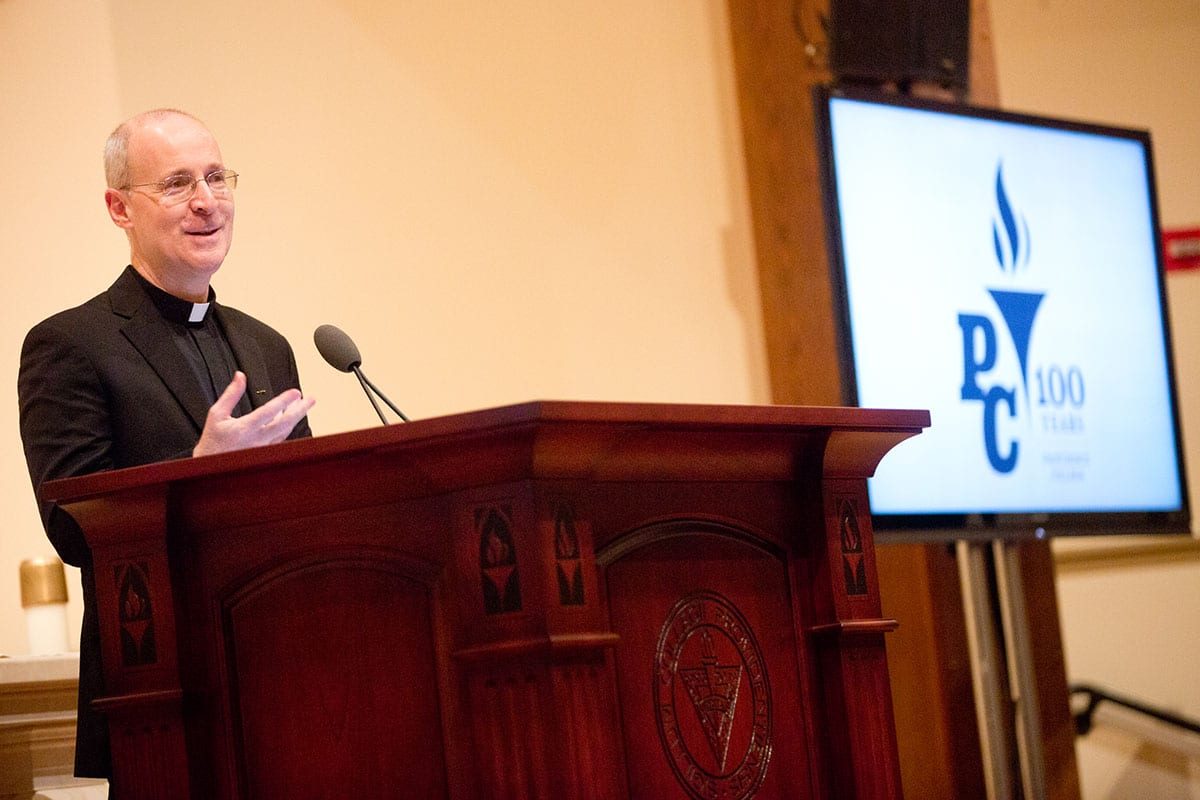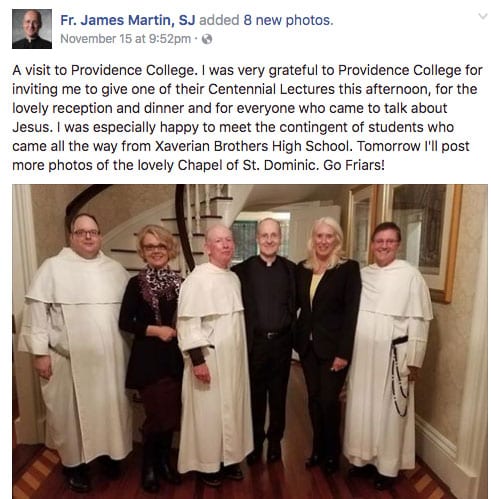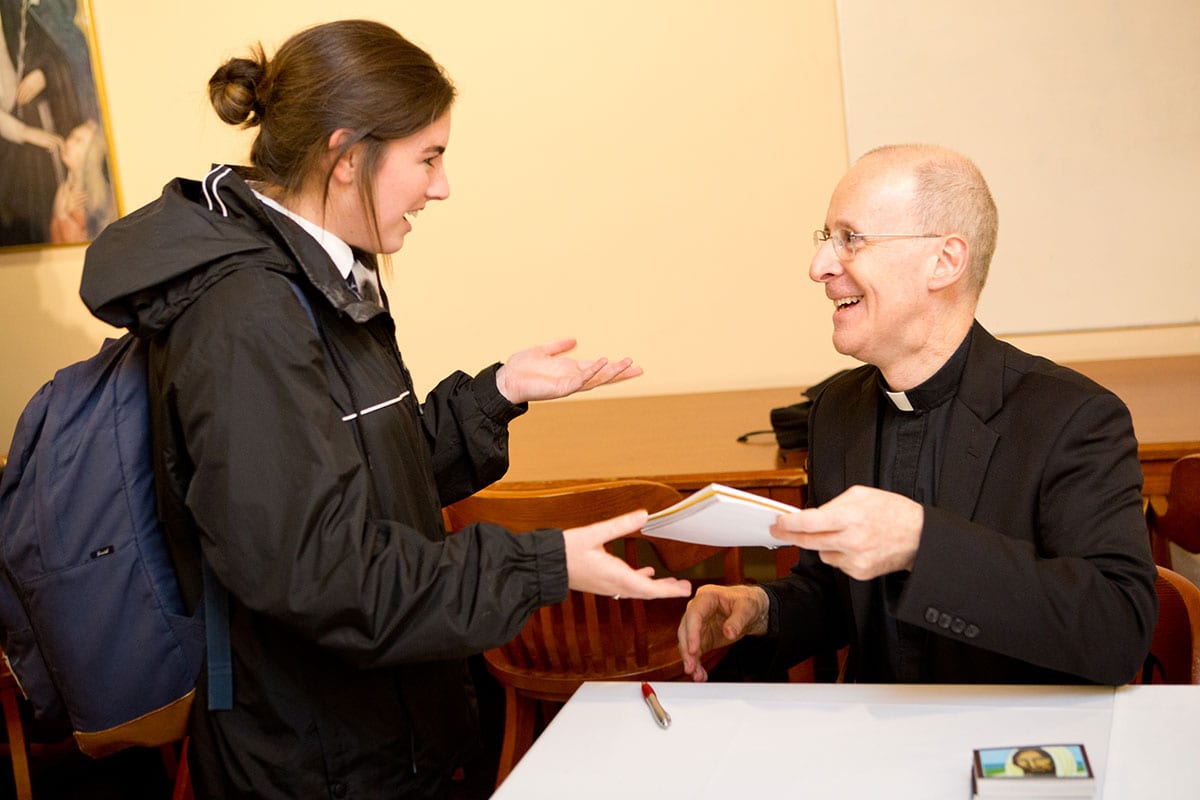November 17, 2016
Rev. James Martin, S.J. discusses the dual natures of Jesus

By Vicki-Ann Downing
Rev. James Martin, S.J., editor at large of America magazine and a media commentator on issues facing the Catholic Church, discussed the human and divine natures of Jesus Christ during a Centennial Presidential Speaker Series presentation at Providence College.
Father Martin presented “Encountering Jesus” on Nov. 15 in St. Dominic Chapel to about 300 members of the College community and the public. Afterward, he took questions from the audience and attended a reception and book-signing.
In his introduction, Rev. R. Gabriel Pivarnik, O.P., vice president for mission and ministry at the College, said he admires Father Martin’s ability to communicate through many channels, including Facebook and Twitter.
While waiting to speak that evening, Father Martin was taking photographs to share with his online followers, Father Pivarnik said. During Father Martin’s recent pilgrimage to the Holy Land, he created an online site so others could share his experience. Father Pivarnik followed it avidly, “and for a couple of weeks this spring, I felt like I was there,” he said.
College President Rev. Brian J. Shanley, O.P. ’80, who welcomed the audience, said he has been “a big fan” of Father Martin for years. He has used two of Father Martin’s books, My Life with the Saints (Loyola Press, 2006) and The Jesuit Guide to (Almost) Everything: A Spirituality for Real Life (HarperOne, 2010) as inspiration for homilies. A third book, Jesus: A Pilgrimage (HarperOne, 2014), allowed Father Shanley to relive a trip he took to the Holy Land with his father.
Father Martin, a native of Pennsylvania, earned a bachelor’s degree in economics from the Wharton School of Business at the University of Pennsylvania in 1982. He worked in corporate finance at General Electric for six years before entering the Society of Jesus, the order known as the Jesuits, in 1988. He received master’s degrees in divinity and theology from the Weston Jesuit School of Theology, now the Boston College School of Theology and Ministry, in Cambridge, Mass., and was ordained a priest in 1999.
Father Martin began working as associate editor at America, the national weekly magazine published by the Jesuits, in 1995. He was culture editor and acting publisher before becoming editor at large. He writes for other national publications, frequently appears as a guest on TV and radio, and speaks and leads seminars around the country. He was a guest speaker at World Youth Day in Brazil.

At PC, “I want to tell a story about the guy that brings us all together — the guy that brought St. Francis together with St. Dominic together with St. Ignatius — Jesus,” said Father Martin.
When Father Martin first was studying for the priesthood, he read a book about the Bay of Parables. It described the location in Galilee where Jesus, hemmed in by crowds, climbed into a boat and asked the apostle Peter to row out so he could speak to those onshore. The book mentioned a naturally occurring amphitheater and excellent acoustics at the site.
“The idea that people could identify exactly where a particular scriptural passage happened really captivated me,” said Father Martin. “I remember thinking, to use some theological language, ‘That is so cool.’”
Ten years later, in a retreat near the ocean in Cohasset, Mass., Father Martin noticed that it was easy to hear the conversations of students who were out sailing. A priest told him that sound travels easily over water and reminded him about the Gospel story of Jesus preaching from the boat.
“That casual insight totally delighted me,” Father Martin said.
Two years ago, during a visit to the Holy Land, Father Martin visited the Bay of Parables and saw the amphitheater. Around the site, he also noticed rocky ground, fertile ground, and thorn bushes — examples used by Jesus in his teaching.
Seeing the site in person was a reminder that “Jesus Christ, the fully divine son of God, is also fully human,” said Father Martin. “Jesus of Nazareth … was not God pretending to be a human being. … Jesus was born and lived and died.”
Jesus’ humanity can be a stumbling block to some Catholics, Father Martin said, just as some others struggle to accept Jesus’ divinity. Thomas Jefferson admired Jesus as an ethical teacher, but did not consider him to be God, so he “scissored out” parts of the Bible he didn’t like and pasted it back together so he could read a version acceptable to him.
“Thomas Jefferson preferred his own version of Jesus,” said Father Martin. “Like many of us, he felt uncomfortable with certain parts of Jesus’ life. Thomas Jefferson wanted a Jesus who didn’t threaten or discomfort him. He wanted a Jesus he could tame, but you can’t tame Jesus. You can’t put him in a box. Humanity and divinity are both part of the story. Omit one or the other, scissor out the uncomfortable parts, and it’s not Jesus we’re talking about anymore, it’s our own creation.”
The division between people “who want just the divine Jesus” and those “who want just a human Jesus” can be explained by looking at two approaches — the people who prefer the Jesus of history and the people who prefer the Christ of faith, Father Martin said.
Television accounts on CNN or the History channel focus on life in first century Galilee, which is important to understanding the times in which Jesus preached, Father Martin said. But those same accounts stop short of discussing Jesus’ miracles, considering that to be part of religion and not history.
“To fully encounter Jesus Christ, the believer needs to understand the Jesus of history and to encounter the Christ of faith,” Father Martin said. “Jesus is always fully human and fully divine. I like to say he’s divine when he’s sawing a plank of wood in the carpentry shop in Nazareth, and he’s human when he’s raising the son of the widow of Nain.
“There’s a lot that we cannot know about Jesus and his humanity and his divinity. It is a mystery. But it’s a beautiful mystery and one I think it’s worth pondering for a lifetime.”






